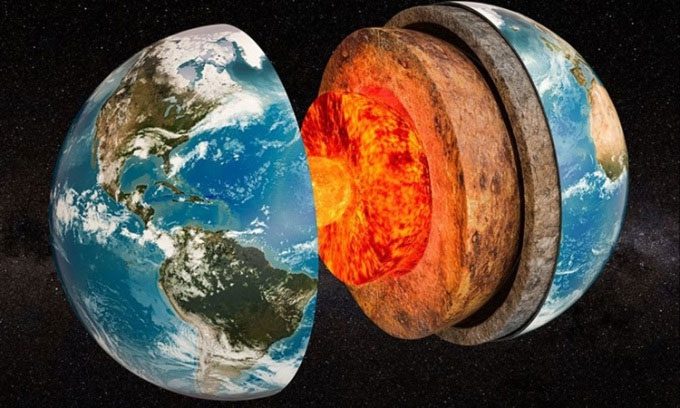Researchers estimate that there is nearly 44 million km3 of water within the Earth’s crust, more than the water found in ice caps and glaciers on the surface.

Simulation of the Earth’s layers. (Photo: AlexLMX).
A 2021 study published in the journal Geophysical Research Letters discovered that the amount of water stored beneath the Earth’s surface in soil or voids within rocks, known as groundwater, is greater than that found in ice caps and glaciers. “There are approximately 43.9 million km3 of water in the Earth’s crust,” said Grant Ferguson, a hydrogeologist at the University of Saskatchewan and the lead author of the 2021 study. For comparison, the ice in Antarctica contains about 27 million km3 of water, Greenland has about 3 million km3, and glaciers outside Antarctica and Greenland hold around 158,000 km3, according to Live Science.
The Earth’s oceans remain the largest water reservoir, containing 1.3 billion km3, according to the study’s findings. Besides the oceans, groundwater is the largest global water reservoir. A 2015 study published in the journal Nature Geoscience estimated there are 22.6 million km3 of water in the shallow subsurface, which refers to water located up to 2 km below the Earth’s surface. In contrast, the 2021 study examined groundwater at depths up to 10 km within the Earth’s crust.
This inconsistency arises from previous estimates of groundwater below the upper 2 km of the Earth’s crust, which focused solely on low-porosity crystalline rocks like granite. The 2021 study included sedimentary rocks that are more porous than crystalline rocks. Overall, the 2021 study found that the amount of groundwater existing at depths between 2 to 10 km below the Earth’s surface increased from approximately 8.5 million km3 to 20.3 million km3. The new estimates also identified groundwater in the shallow subsurface at nearly 23.6 million km3.
According to Ferguson, the crust typically ranges from 30 to 50 km thick, much thicker than the depth examined in the 2021 study. They focused on the upper crust because that part is relatively brittle, thus possessing many fractured rocks that can hold water. Below a depth of 10 km, the crust becomes less porous and less capable of containing water.
The aquifers, primarily freshwater, near the surface are used for drinking water and irrigation. Conversely, groundwater at greater depths is often quite saline and cannot easily circulate or rise to the surface, thus isolating it from the rest of the planet’s water supply, according to Ferguson. However, this isolation of the deep groundwater means that in some locations, saline water has been stored for extremely long periods, potentially providing valuable insights into Earth’s past.
Additionally, ancient water may support microbial ecosystems that are still active today. Such deep biological communities could help clarify how life evolved on Earth and how it may develop in other worlds.




















































